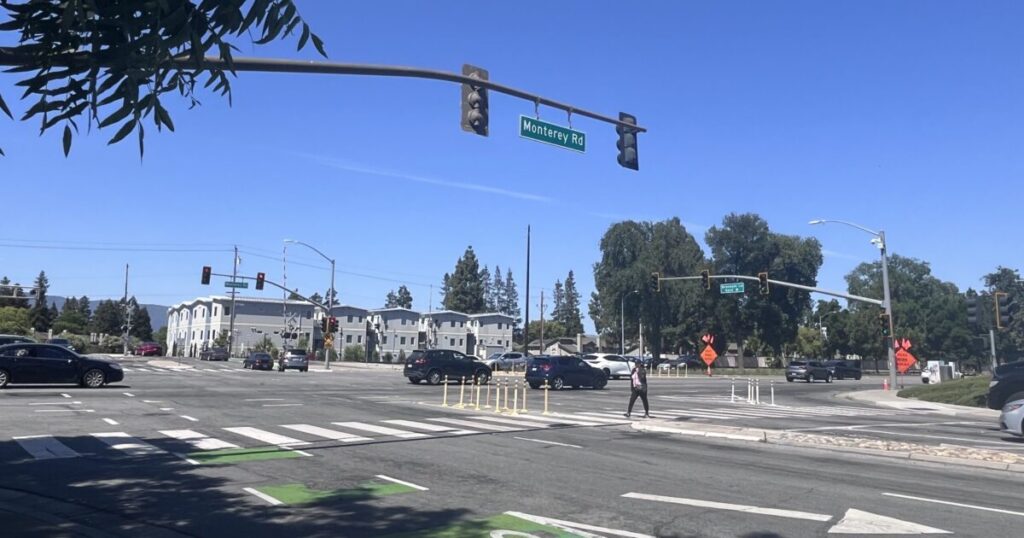San Jose is doubling down on traffic safety, and red light runners and speeding drivers need to pump the brakes if they don’t want to pay hundreds of dollars in fines.
Red light cameras will be installed at four major city intersections by late July and activated in early August as part of a one-year pilot program. Cameras will activate if a car enters the intersection after the light turns red, capturing video footage and still photos of the license plate and driver. Red light violations count as a point on a driver’s record. The fine for running a red light is $486, and making a rolling right turn on red is a $234 fine. The San Jose Police Department will review images before tickets are sent to vehicle owners.
District 3 Councilmember Carl Salas, who attended a recent community meeting on the issue, sees it as raising public safety awareness.
“We’ve had a lot of pedestrian deaths and bicycles get hit all the time,” he told San José Spotlight.
From 2019 to 2023, 64 individuals were killed and 409 severely injured in 7,671 car crashes due to speeding and running red lights, according to the San Jose Department of Transportation.
Colin Heyne, transportation department spokesperson, said camera placements were chosen based on the locations of severe crashes, drivers failing to yield to pedestrians or bicyclists and driving 10 mph or more over the speed limit.
Red light cameras will be located at the intersections of Leigh and Parkmoor avenues, Monterey Road and Branham Lane, South Third and Keyes streets, and Bascom and Camden avenues. Funding for the $733,000 program comes from the city budget. After a year, the City Council will review its effectiveness and decide to keep, expand or end the pilot.
Another traffic safety program planned for fall aims to stop speeding as part of Vision Zero San Jose, a citywide initiative to eliminate traffic deaths. The speed safety program will install 33 cameras at high-risk locations where speeding has led to serious injuries and fatalities. Cameras are triggered when vehicles go 11 mph above the speed limit. The cameras will photograph a vehicle’s rear license plate and a citation will be mailed to the vehicle’s registered owner.
The California Legislature authorized the pilot for up to five years, or until January 2032, in six cities: San Jose, Oakland, San Francisco, Long Beach, Los Angeles and Glendale. The program is estimated to cost between $15.4 million to $17.9 million over five years.
Heyne said speeding camera fines are low, but high enough to prevent people from speeding. Fines for driving over the speed limit range from $50 to $500: 11-15 mph over the speed limit is a $50 fine, 16-25 mph over the speed limit is $100 and 26 mph or more is $200. Driving 100 mph or more results in a $500 fee.
“I’m the person that’s gotta get on the news and talk about it every time we lose a life on our streets,” he told San José Spotlight. “People have accused us of trying to profiteer off these tickets. If we do not write a single ticket for either of these programs, it will be a success because that will mean people are stopping at red lights and they’re obeying the speed limit. We are not trying to be punitive with this program. We want to save lives.”
The San Jose Police Department is already using license plate reader cameras and the transportation department’s camera feed. Its cameras have previously been used to adjust traffic signal timing to alleviate backups.
Both programs will have a 60-day grace period. Drivers caught speeding or running a red light will first receive a warning. In addition, a driver’s first violation of 11 to 15 mph over the speed limit will result in a second warning. Fine reductions are in place for low-income residents.
Resident Rita Torres hopes the cameras will change people’s behavior.
“People run red lights all the time. I’ve seen up to three cars coming through at Third and Keyes,” Torres told San José Spotlight. “There are a lot of people who don’t seem to know what a red light is. People don’t stop when they see a red light and they’re going to make a right turn. They just take that turn and it terrifies me.”
Contact Lorraine Gabbert at [email protected].



